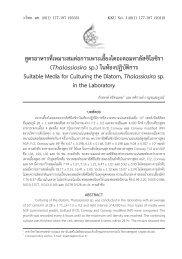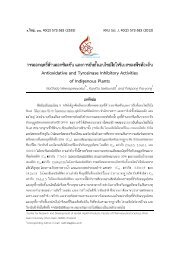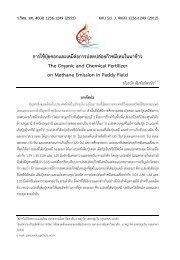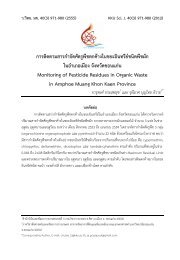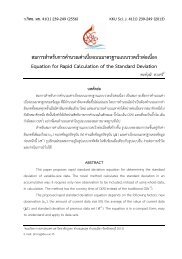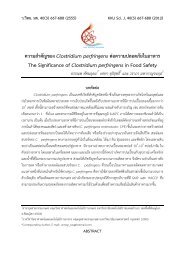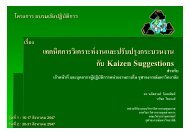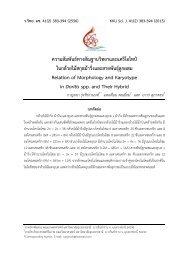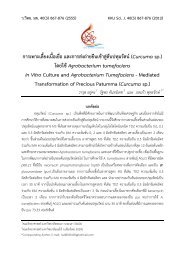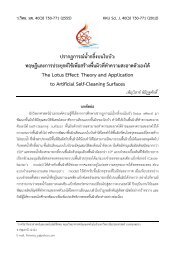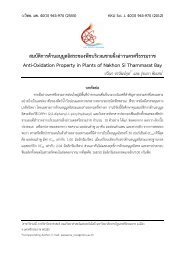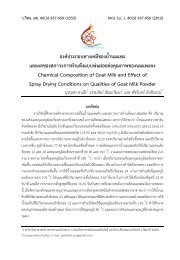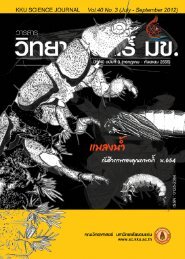Review
Review
Review
Create successful ePaper yourself
Turn your PDF publications into a flip-book with our unique Google optimized e-Paper software.
ß“π«‘®—¬<br />
«“√ “√«‘∑¬“»“ µ√å ¡¢. ªï∑’Ë 39 ©∫—∫∑’Ë 1 109<br />
Relationship between fingerprint pattern<br />
and multiple intelligence<br />
The ANOVA showed that only the mean<br />
score of the logical-mathematical MI had a<br />
statistical significant difference between three types<br />
of fingerprint patterns on the right middle finger i.e.<br />
whorl, ulnar loop, and arch [F (2,70)<br />
=4.42, p=0.02). In<br />
other words, pattern type on the right middle finger<br />
is able to indicate a subject who has a high mean<br />
score of the logical-mathematical MI. The other MI<br />
mean scores show no significant difference between<br />
groups of fingerprint pattern types. The next step<br />
of the analysis was to identify which type of<br />
fingerprint pattern on the right middle finger is<br />
able to indicate high mean scores of the logicalmathematical<br />
MI. Considering frequencies of each<br />
pattern type on the right middle finger, it was found<br />
that the ulnar loop was the most prevalent (59.7%),<br />
38.9% showed the whorl and only 1 subject (1.4%)<br />
had the arch. Thus the least frequency was deleted<br />
resulting in 71 subjects for the next analysis using<br />
the independent sample t-test. Results showed that<br />
the group of the whorl type had a significantly<br />
higher logical-mathematical MI mean score (29.21)<br />
than that of the ulnar loop type (26.12) [t (69)<br />
=-3.03,<br />
p=0.002]. This indicates that the whorl type<br />
pattern on the right middle finger is related to the<br />
logical-mathematical MI.<br />
Regarding analyses of an individualûs<br />
fingerprint pattern type and MI score as shown in<br />
Fig. 2, it helps each subject to know both of his<br />
or her eight multiple intelligences in ranking and<br />
the types of fingerprint patterns.<br />
Discussion<br />
The reliability of the MI checklist of<br />
this study was quite high and similar to that of a<br />
previous study (alpha Cronbach=0.911) by Sintuwong<br />
(2002) probably caused by similarity of subjectsû<br />
characteristics and words using in questions which<br />
had been adapted for students.<br />
The logical-mathematical MI mean score<br />
ranks the highest among the present studyûs subjects<br />
and the previous one by Sintuwong (2002) because<br />
both were students from the Science and Technology<br />
field. Remarkably, students who study in the<br />
Science and Technology field have highly intelligence<br />
in logical-mathematics.<br />
Authentic assessment of MI, documentation<br />
of individual profiles and problem-solving, can be<br />
performed by using several kinds of tools for data<br />
collection (Armstrong, 1994) for example; anecdotal<br />
records, work samples, audio cassettes, video tapes,<br />
photography, sociograms, informal tests, checklists<br />
etc.<br />
Types of fingerprint pattern by fingers<br />
particularly on the left and right thumbs seem to be<br />
comparable to the previous study which had a larger<br />
sample size of 684 subjects (Nanakorn et al.,<br />
2007). The previous study revealed significant sex<br />
differences of fingerprint pattern types on the left<br />
and right thumbs, while the present study had too<br />
small sample size to determine this statistically.<br />
The sample size of this pilot study<br />
encourages researchers to calculate the appropriate<br />
sample size for future study of 1893 subjects<br />
(Lemeshow et al., 1990; Nanakorn et al., 2009) for<br />
investigation of 8 MI and fingerprint pattern<br />
typesû relationships.



